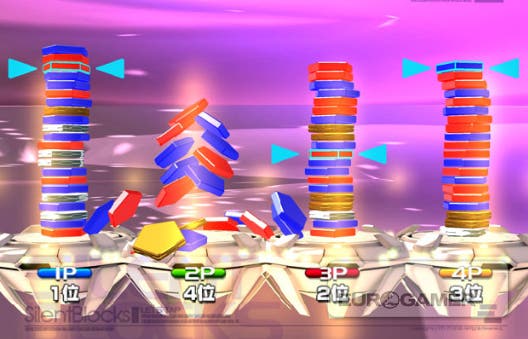Let's Tap
Thinking outside the box.
When you first open Let's Tap's oversized box and pull out about seven nicely decorated pieces of cardboard, which the packaging implores you to assemble into further boxes and rest your Wiimote upon, it makes absolutely no sense. In the same way that Wii Sports Tennis has people waving tentatively the first time they play it, reluctant to believe that their actions will translate onto the screen in any meaningful way, there's a bit of a belief barrier between the average person and accepting that you can control a videogame by tapping a cardboard box.
Still, let's play along. Assemble the boxes, rest your Wiimotes face-down on top of them, stick in the disc, and a tutorial appears, which won't help out much in the sense-making department if you don't read Japanese. Thankfully that's the full extent of the language barrier here - once you make it through to the main menu and into one of Let's Tap's five mini-games, it all falls into place. The game's control system is so simple and so natural that it almost defies explanation; you'll watch others tapping away with a furrowed brow, but as soon as you sit down to play you suddenly understand what to do without a shred of clarification.
We'll give it a go anyway. There are five different games, each controlled by tapping the box. It doesn't need to be a special Let's Tap-branded box, obviously - discarded pizza boxes work just as well. It registers hard, medium and light taps, but that rarely comes into play. One tap moves between options in menus and two taps selects, or you can pick up the Wiimote and point for easy navigation. The menus are all bright orange, loud and energising and bolstered by arcade-style Japanese techno, and each of the arcadey mini-games has its own, endearingly minimalist visual design. There's a definite old-school SEGA flavour about the place.

Rhythm Tap is the simplest and most obvious of the game concepts on show here. It's an uncomplicated rhythm game where beats scroll towards you from the left, and you match them with light, medium or hard taps. Any tap at all will keep your combo going - getting the velocity right is only important for high-scoring. Twelve thumping, techno-ey, occasionally bouncy J-pop tracks provide the soundtrack, and though they never get particularly hard, they're an ample enough challenge for the after-pub Wii multiplayer crowd.
Like all of Let's Tap's games, Rhythm Tap is best in multiplayer. Like lovely, neglected old Donkey Konga used to, Rhythm Tap gives each different player a slightly different part to play. You can get a pretty good symphony of rhythmic tapping going in combination with obnoxiously loud, repetitive music if you want to be especially popular with non-participating bystanders in your flat/Japanese dormitory.

Tap Runner, though, holding pride of place on the selection screen, is without a doubt the star of the show. Four little men line up at the start of an abstract neon racecourse, four players furiously tap through hazards and across gaps and past infuriating traps, and one emerges victorious in a flurry of insults, yelps of agony and thrown cardboard boxes. Tapping lightly in rhythm gets your man running at speed and bashing the box makes him jump, and that's the extent of the controls; the complexity comes from the courses themselves, which progress from simple running and jumping to incorporate tightrope-walking, trapeze-swinging, electric traps and warp gates.








